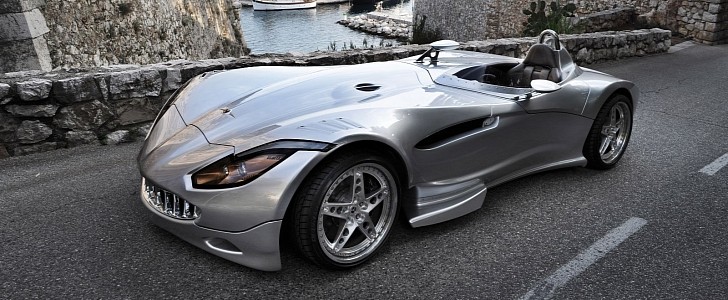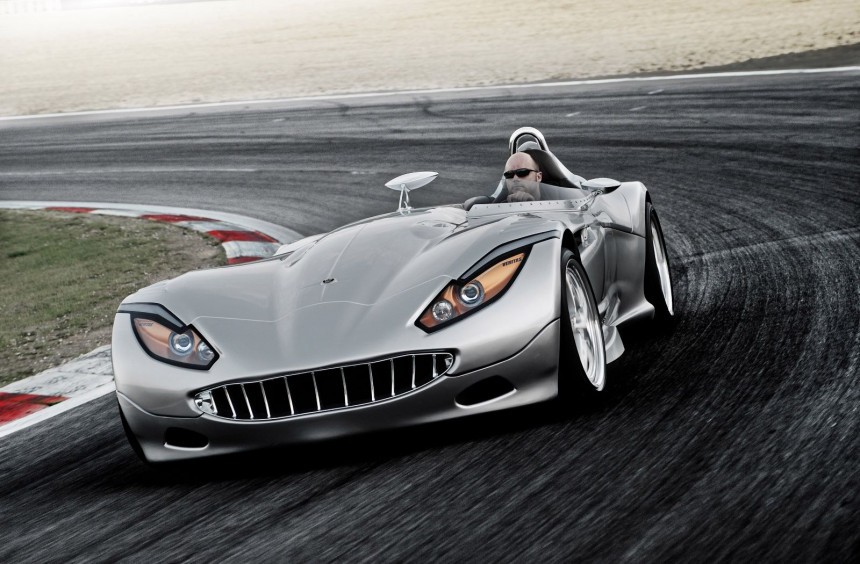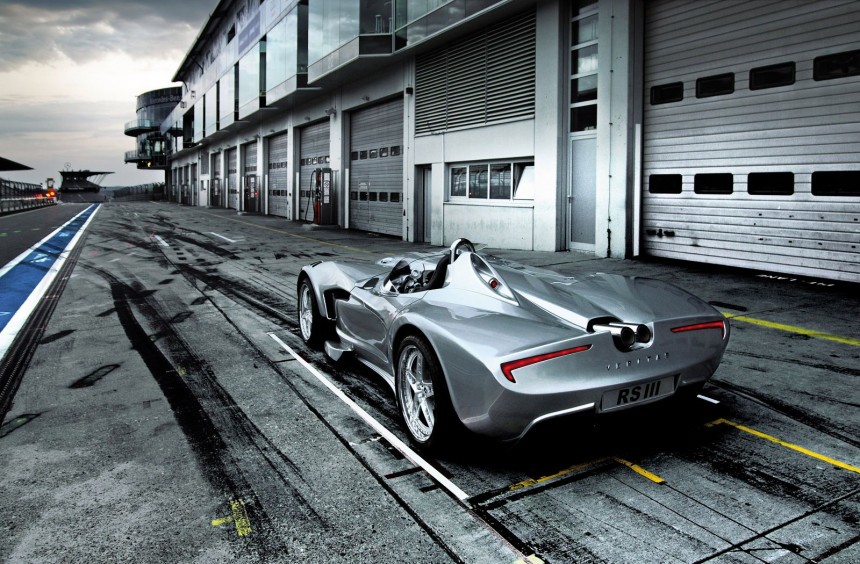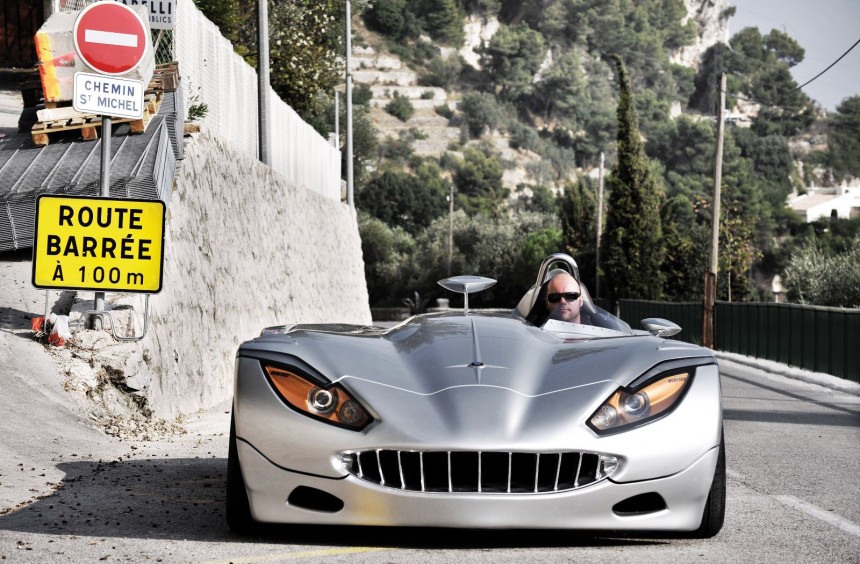Inspired by a successful German race car from the late 1949s, the RS III was a beautiful two-seat roadster conceived to deliver the ultimate driving experience on both road and track.
Originally established in 1946 by BMW engineers Ernst Loof, Lorenz Dietrich, and Georg Meier, Veritas started by rebuilding and tuning pre-war BMW 328s. A few years later, the company became a full-blown manufacturer that used BMW chassis and powertrains to create their own road and race cars.
On the track, the most successful model was the aluminum-bodied RS which dominated the 2.0-liter sports car class in West Germany between 1948 and 1949. Driven by Karl Kling, the car is remembered for sweeping the competition at the 1948 Nürburgring race where it finished on top by a large margin and averaged a speed of 100 mph (161 kph).
Despite quickly making a name for itself in the world of motorsport and becoming the first German manufacturer to compete in Formula 1, Veritas began to struggle financially during the early 1950s. It failed to recover and was eventually forced to close shop in 1953.
Nearly half of century later, the brand was revived when a new company called Vermot AG, was founded with the aim of creating a modern reinterpretation of the 1940s RS roadster.
Dubbed RS III, the car was revealed to the public in concept form in 2001. With a stunning, aggressively shaped body, a cutting-edge, race-bread chassis, and a powerful BMW M-engineered 6.0-liter V12 capable of close to 650 hp, it blew people’s minds right off the bat. The excitement surrounding the RS III grew even further when the company announced that a limited production run of 30 units would commence soon.
However, eight years would pass until a street-legal, production version was built at Veritas’ Nürburg headquarters, located a few miles from the famous Nürburgring Nordschleife.
The breathtaking roadster bodywork of the initial concept was extensively revamped to meet safety requirements, but, fortunately, it looked even better. Made out of carbon fiber, the lightweight structure employed a 1+1-seater configuration with a removable, body color-painted panel on the passenger side. It combined modern and classic elements into a spectacular package that resembled a shark ready to pounce on its prey.
Underneath the gorgeous body was a tubular steel frame chassis that used motorsport-derived double wishbones on all four corners with pushrod-operated, horizontally opposed coilovers curtesy of Öhlins. Stopping power was provided by a BT Racing braking system which included huge six and four-pot calipers that hugged ceramic discs measuring 380 mm (14.9 inches) in front and 355 mm (13.9 inches) at the rear.
The massive V12 that powered the concept was dropped due to stricter emission standards, but another brilliant BMW M engine took its place. Introduced in the E60 M5, the S85 was BMW's first and only production V10 and its design was inspired by the Formula One powerplants that the Bavarians had developed between 2000 and 2005.
Mounted in a front-mid position, the all-aluminum unit displaced 5.0 liters and came with impressive hardware such as electronically actuated individual throttle bodies, oil-cooled, cast aluminum pistons, or a semi-dry-sump lubricating system.
Linked to either a seven-speed SMG or a good old-fashioned six-speed manual, it could spit out 507 hp and 383.5 lb-ft (520 Nm) of torque. All that power was deployed to the rear wheels through a Drexler mechanical limited-slip differential.
Although not as capable as the concept’s V12, the S85 was good enough to propel the 2,381-pound (1,080 kg) RS III to 60 mph (97 kph) from a standstill in a little over 3 seconds. Even more impressive, the roadster could reach a top speed of 215 mph (346 kph) thanks to the BMW M unit and its aerodynamically-efficient body.
After extensive testing on both the neighboring Nordschleife and the legendary Brands Hatch racetrack in England, the limited production run kicked off in late-2009. All 30 cars were hand-assembled by a small team of fifteen experienced engineers, and, according to the manufacturer, most of them were sold to eager customers long before being built. The price for one started around $490,000 ($660,321 today), but, with bespoke modifications, it could reach well over $600,000 ($808,557 today).
Automotive magazines that got to review it, praised its maneuverability and well-balanced chassis, which seemed to complement the BMW M powertrain perfectly.
Encouraged by the positive feedback, Veritas announced plans for another limited production run of upgraded versions with hybrid and fully electric powertrains. Sadly, this never happened, and the company eventually faded away into oblivion.
While it never got the exposure it deserved, the Veritas RS III was one of those rare supercars that drove as well as it looked. A modern reinterpretation of a classic racecar, it remains one of the most outrageous production vehicles to feature a BMW M engine.
On the track, the most successful model was the aluminum-bodied RS which dominated the 2.0-liter sports car class in West Germany between 1948 and 1949. Driven by Karl Kling, the car is remembered for sweeping the competition at the 1948 Nürburgring race where it finished on top by a large margin and averaged a speed of 100 mph (161 kph).
Despite quickly making a name for itself in the world of motorsport and becoming the first German manufacturer to compete in Formula 1, Veritas began to struggle financially during the early 1950s. It failed to recover and was eventually forced to close shop in 1953.
Nearly half of century later, the brand was revived when a new company called Vermot AG, was founded with the aim of creating a modern reinterpretation of the 1940s RS roadster.
However, eight years would pass until a street-legal, production version was built at Veritas’ Nürburg headquarters, located a few miles from the famous Nürburgring Nordschleife.
The breathtaking roadster bodywork of the initial concept was extensively revamped to meet safety requirements, but, fortunately, it looked even better. Made out of carbon fiber, the lightweight structure employed a 1+1-seater configuration with a removable, body color-painted panel on the passenger side. It combined modern and classic elements into a spectacular package that resembled a shark ready to pounce on its prey.
The massive V12 that powered the concept was dropped due to stricter emission standards, but another brilliant BMW M engine took its place. Introduced in the E60 M5, the S85 was BMW's first and only production V10 and its design was inspired by the Formula One powerplants that the Bavarians had developed between 2000 and 2005.
Mounted in a front-mid position, the all-aluminum unit displaced 5.0 liters and came with impressive hardware such as electronically actuated individual throttle bodies, oil-cooled, cast aluminum pistons, or a semi-dry-sump lubricating system.
Linked to either a seven-speed SMG or a good old-fashioned six-speed manual, it could spit out 507 hp and 383.5 lb-ft (520 Nm) of torque. All that power was deployed to the rear wheels through a Drexler mechanical limited-slip differential.
After extensive testing on both the neighboring Nordschleife and the legendary Brands Hatch racetrack in England, the limited production run kicked off in late-2009. All 30 cars were hand-assembled by a small team of fifteen experienced engineers, and, according to the manufacturer, most of them were sold to eager customers long before being built. The price for one started around $490,000 ($660,321 today), but, with bespoke modifications, it could reach well over $600,000 ($808,557 today).
Automotive magazines that got to review it, praised its maneuverability and well-balanced chassis, which seemed to complement the BMW M powertrain perfectly.
Encouraged by the positive feedback, Veritas announced plans for another limited production run of upgraded versions with hybrid and fully electric powertrains. Sadly, this never happened, and the company eventually faded away into oblivion.
While it never got the exposure it deserved, the Veritas RS III was one of those rare supercars that drove as well as it looked. A modern reinterpretation of a classic racecar, it remains one of the most outrageous production vehicles to feature a BMW M engine.












